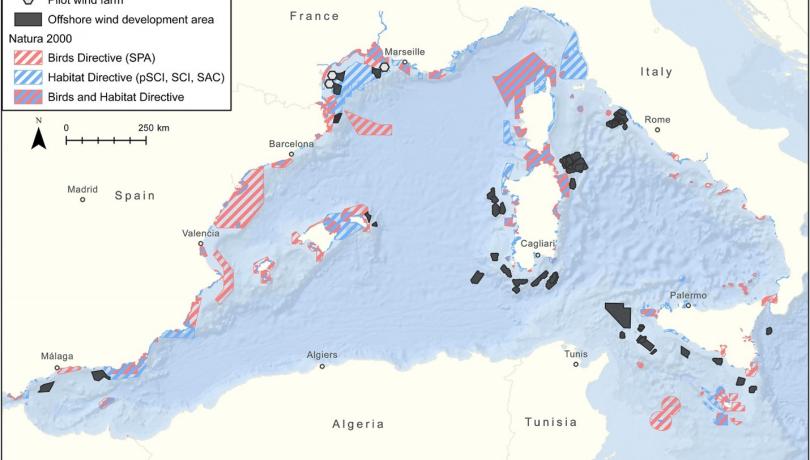This is the main conclusion of a study with the participation of the ICM-CSIC which describes this interaction as "remarkable" and calls for "caution".

A study conducted by an interdisciplinary scientific team from the University of Girona (UdG), the Institut de Ciències del Mar (ICM-CSIC), the University of Barcelona (UB), the International University of La Rioja (UNIR) and the Polytechnic University of Catalonia (UPC) launches new results on "the remarkable interaction between offshore wind projects and marine protected areas in the Western Mediterranean". The work shows that nine offshore wind energy zones and one pilot project overlap or border marine protected areas that are part of the Natura 2000 Network.
Currently, there are 47 zones and three pilot projects in the Western Mediterranean aimed at developing offshore wind energy, initiatives that seek to harness the wind power produced offshore to generate electricity. Of this total, the study details that four of these zones and one pilot project overlap with a Natura 2000 marine protected area; five zones are adjacent; and 90% of the rest are located at a distance of less than 30 kilometers.
The scientific team, made up of specialists in marine biology, physical oceanography, geography, law and engineering, calls for "caution" in the study recently published in the international journal ICES Journal of Marie Science with the title Floating offshore wind farms in Mediterranean marine protected areas: a cautionary tale. The research is the result of the BIOPAIS project, coordinated by the University of Girona and supported by the Biodiversity Foundation of the Ministry for Ecological Transition and the Demographic Challenge (MITECO) within the framework of the Recovery, Transformation and Resilience Plan (PRTR), financed by the European Union - NextGenerationEU.
The article evaluates for the first time in the Mediterranean the development of offshore wind energy in or around Natura 2000 sites and other protected areas with categories such as officially declared areas to conserve birds (IBA), marine mammals (IMMA) or sharks and rays (ISRA). The scientific team has taken as an example the Western Mediterranean and, specifically, the cases of France, Italy and Spain, where most of the wind projects in this sea have been proposed. The study outlines the regulatory context of Natura 2000 sites and other marine protected areas in the Mediterranean in relation to offshore wind energy development; summarizes the potential impacts of offshore wind energy on habitats and species protected by EU regulations; and assesses the interactions of offshore wind projects, Natura 2000 sites and ten other biodiversity protection figures.
Finally, the work includes recommendations to address the development of offshore wind power to preserve marine protected areas from the potential negative effects of the installation of these energy infrastructures, mostly floating turbines, "a very incipient technology for which there is still very little information on its ecological impacts".
The study also looks at the Gulf of Lions, from Marseille to Cap de Creus, where there are four offshore wind development zones and three pilot projects that overlap or are adjacent to several marine protected areas. Some of these areas have the Natura 2000 seal and others have been designated for decades to protect or restore marine biodiversity and fishery resources. The Golf de Roses/Cap de Creus is one of these four development zones, which overlap or border ten marine protected areas. Members of the research team studied this area in detail in a previous scientific paper published in the journal Science of Total Environment. Recently, the Gulf of Roses and Cap de Creus area has been declared an important shark and ray conservation area (ISRA).
This study concludes that, as a general rule and as a priority, offshore wind energy development in the Mediterranean should be excluded from Natura 2000 sites and any other marine protected areas, as well as their adjacent areas. The authors of the research consider that this standard should also "include pilot tests".
Furthermore, the study stresses that "it should not be taken for granted that the development of this type of projects can be beneficial for biodiversity, as some studies in the North Sea conclude, as this should be analyzed on a case-by-case basis, especially in a sea like the Mediterranean, where there are no studies in this regard." "In all cases, the Precautionary Principle should be respected taking into account the deep interaction between marine protected areas and offshore wind projects, and the little existing information on the ecological impacts of floating wind - such as the one that is mostly wanted to be installed in the Mediterranean, for example, in the Golf de Roses -, unlike what happens with fixed wind, basically used in the North Sea", state the signatories of the scientific article.
The study stresses the need for appropriate scientific assessments to be carried out, as indicated by European regulations, for projects that may affect Natura 2000 areas. "These evaluations, which are mandatory, must be rigorous and independent of the studies of the promoting energy companies and must determine, case by case, the feasibility or otherwise of each project," the researchers add. "Although these initiatives can bring benefits in terms of CO2 reduction and energy security, the risks to the ecological integrity of the protected areas concerned must be carefully assessed," they say. Although this study focuses on the Western Mediterranean, the authors believe that the lessons learned may be useful for other seas and oceans.